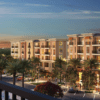Egypt is swiftly progressing in the development of its New Administrative Capital (NAC), a massive project 30 miles east of Cairo that aims to provide a modern and well-planned environment for businesses, residents, and government institutions. Initiated by President Abdel Fattah al-Sisi, the NAC is progressing and intends to accommodate Egypt’s growing population and relieve the congestion and urban sprawl in the existing capital. Construction of the 270-square-mile city began in 2016, and upon completion, it could accommodate 6.5 million people.
Among the various projects planned for the NAC, there are a range of impressive and innovative developments aimed at both the public and private sectors. These prospective projects include Africa’s tallest building, a crystal pyramid, and a vast, disc-shaped palace, as well as several sustainable infrastructure projects that align with Egypt’s Vision for 2030. This long-term strategic plan endeavors to achieve sustainable development across all major socio-economic sectors in the country.
Thus, the New Administrative Capital of Egypt showcases the nation’s ambitious plans for the future, with its cutting-edge architecture, sustainable urban planning, and focus on transforming Egypt’s socio-economic landscape. As the city continues to rise, these prospective projects will become major landmarks and driving forces for growth in the region.
Overview of The New Administrative Capital
The New Administrative Capital (NAC) is a mega project situated about 45 kilometers east of Cairo. The project began in 2015 and encompasses a land area of around 700 square kilometers. It aims to become the new capital of Egypt, alleviating Cairo’s congestion and creating a modern hub.
Strategic Importance
The NAC holds great strategic significance for Egypt, as it will reduce overcrowding in Cairo and provide a more modern and sustainable urban environment. Upon completion, the new city is expected to accommodate around 7 million residents. Moreover, government institutions and foreign embassies will be relocated to the NAC to facilitate centralized administration.
One of the goals of NAC is to attract foreign investment and position Egypt as a key player in the global economy. The city will feature state-of-the-art infrastructure, technology, and urban planning, promoting sustainable living and economic growth.
Infrastructure Development
The NAC’s infrastructure has been designed with the future in mind, integrating innovative technology, advanced transportation systems, and sustainable energy solutions. It will be home to several iconic buildings, including Africa’s tallest building and a crystal pyramid-shaped venue.
Key infrastructure projects include:
- A smart city system using digital technology for efficient management of public services.
- A vast road network, including a new expressway connecting NAC to Cairo.
- A sustainable and diverse energy grid, using solar and wind power.
- State-of-the-art public transportation system, including a monorail and electric buses.
Emphasizing sustainability, the city will also have several green spaces, including parks and recreational areas, contributing to the overall health and well-being of its residents, and demonstrating Egypt’s commitment to creating an eco-friendly urban landscape.
Prospect Projects
Commercial Ventures
The New Administrative Capital in Egypt is projected to bring forward numerous commercial ventures. It promises to provide ample opportunities for businesses by encompassing Africa’s tallest building and a crystal pyramid. Several opinions expect that these iconic structures will attract both local and international investors, fostering economic growth and creating job opportunities.
Residential Complexes
Along with commercial growth, residential complexes are being extensively developed in the New Administrative Capital. Prospective residents will benefit from a variety of housing options catering to different budgets and preferences. These developments will provide world-class living standards and modern amenities, making the capital a desirable place to call home.
Cultural Landmarks
Egypt’s new capital aims to establish itself as a hub of cultural landmarks. The disc-shaped presidential palace inspired by symbols from ancient Egypt promises to be a major attraction. The city plans to showcase Egyptian history and culture through various museums, galleries, and performance spaces, making it a vibrant cultural destination.
Technological Hubs
The New Administrative Capital is investing heavily in modern technological infrastructure to support innovation. Among these initiatives is the Knowledge City project, which covers 200 acres and has a total investment of 15 billion pounds. Once complete, this hub will promote the growth of communication sciences, information technology, and related fields.
Educational Institutions
Education plays a pivotal role in the progress of the New Administrative Capital. As part of its strategic vision, the city intends to establish world-class educational institutions. Among these establishments is the Egypt Informatics University, slated to offer specialized courses in communication sciences, information technology, and relevant domains.
Healthcare Facilities
Recognizing the importance of healthcare, the New Administrative Capital is investing in state-of-the-art healthcare facilities. These institutions will be equipped with cutting-edge technology and staffed by skilled medical professionals, ensuring that residents receive the best medical care possible. With modern hospitals and clinics, the capital will prioritize the well-being of its inhabitants.





